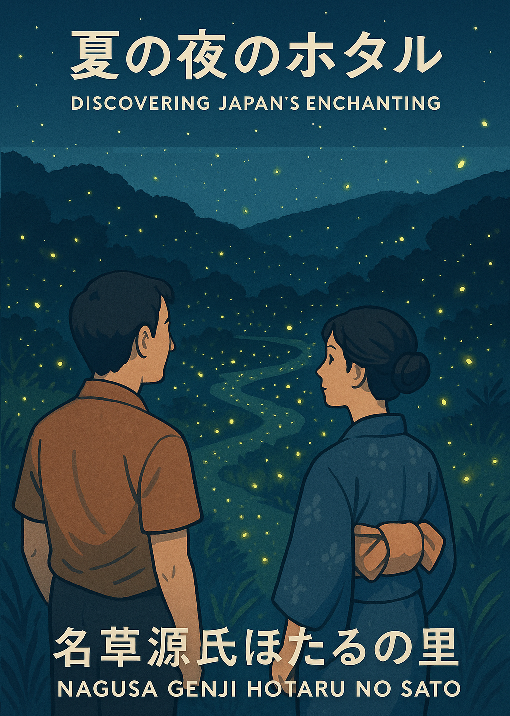
Jun 15, 2025
As the early summer dusk settles over the countryside of Ashikaga in Tochigi Prefecture, tiny lights begin to dance in the air. These are Genji-botaru, a species of firefly unique to Japan, and they’re the stars of the Nagusa Hotaru Festival, held annually at Nagusa Genji Hotaru no Sato. Running until June 22nd, this magical event draws visitors from all over the region to witness a natural phenomenon that lasts only a few short weeks each year.
Locals describe the experience as deeply emotional. “You can only see this kind of light during this season,” one man said, watching the fireflies glow in the dark. “It feels like time slows down.” The festival takes place every evening from around 7:00 PM to 9:00 PM and is supported by donations—500 yen or more per car—to help maintain the delicate environment needed for the fireflies to thrive.
More Than Just Insects: A Cultural Symbol
In Japan, fireflies—or hotaru—are more than just insects. They are symbols of impermanence, beauty, and the changing seasons. Their brief, glowing lives have inspired poetry, music, and even films like Grave of the Fireflies. Watching them flicker silently in the night sky evokes a uniquely Japanese sense of mono no aware—a gentle awareness of the transience of things.
Protecting the Glow: Community and Conservation
Fireflies are incredibly sensitive to pollution and habitat destruction. That’s why local groups like the Nagusa Genji Hotaru Preservation Society play a crucial role. They work year-round to create a safe breeding environment, protect the local waterways, and raise awareness about biodiversity. Visitors to the festival are encouraged to walk quietly, avoid flashlights or bright phone screens, and donate to the cause.
Across Japan, similar efforts are underway. From Kyoto to Nagasaki, more communities are rediscovering the cultural and ecological value of hotaru—and finding new ways to protect them for future generations.
A Magical Invitation
If you love Japan’s nature and traditions, experiencing a firefly festival should be on your travel list. It’s not just a visual treat—it’s a moment of calm, a connection to the past, and a reminder of the delicate balance between people and nature.
As the lights of the city fade and the soft glow of fireflies fills the air, you’ll understand why hotaru have captured the hearts of the Japanese for centuries.
夏の夜のホタル:日本の魅力的な「ホタル文化」を知る
初夏の夕暮れが栃木県足利市の田園地帯に降りると、小さな光が空中で踊り始めます。これらは日本固有のホタルの一種であるゲンジボタルで、彼らは毎年恒例の名草ホタル祭りの主役です。この幻想的なイベントは、名草源氏ほたるの里で6月22日まで開催されており、この短い時期にしか見られない自然現象を目当てに、地域中から多くの人が訪れます。
地元の人々はこの体験を非常に感動的なものだと表現します。「この季節にしか見られない光だ」と、ある男性は闇夜に光るホタルを見つめながら語りました。「時間がゆっくりと流れているように感じる」。祭りは毎晩、午後7時ごろから9時ごろまで行われており、ホタルの環境を保護するため、来場者には車1台あたり500円以上の寄付が呼びかけられています。
単なる昆虫以上の存在:文化的な象徴
日本において、ホタル(=ホタル)は単なる昆虫ではありません。彼らは無常、美しさ、季節の移ろいの象徴です。その短く輝く命は、詩や音楽、さらには『火垂るの墓』のような映画にまでインスピレーションを与えてきました。闇の中で静かにまたたくその姿は、日本独特の「もののあはれ」――物事の儚さに対する優しい気づき――を呼び起こします。
光を守る:地域と保全活動
ホタルは汚染や生息地の破壊に非常に敏感です。だからこそ、名草源氏ホタル保存会のような地域団体が重要な役割を果たしています。彼らは一年を通して、安全な繁殖環境を整え、地元の水路を守り、生物多様性への意識を高める活動をしています。祭りの来場者には、静かに歩き、懐中電灯やスマートフォンの強い光を避け、保全活動への寄付をするよう呼びかけられています。
日本全国でも、同様の取り組みが進められています。京都から長崎に至るまで、多くの地域社会がホタルの持つ文化的・生態学的な価値を再発見し、次の世代のためにそれを守る新たな方法を見つけつつあります。
魔法のような招待
もしあなたが日本の自然や伝統を愛しているなら、ホタル祭りを体験することは旅のリストに加えるべきものです。それはただの視覚的な楽しみではなく、静けさのひとときであり、過去とのつながりであり、人と自然の繊細なバランスを思い出させるものです。
街の灯が遠のき、ホタルのやわらかな光が空気を満たすとき、なぜホタルが何世紀にもわたり日本人の心をとらえてきたのか、あなたはきっと理解するでしょう。
